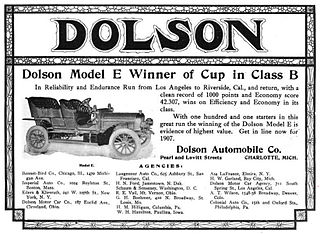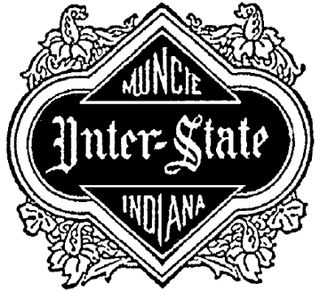
Automobiles Ettore Bugatti was a German then French manufacturer of high-performance automobiles. The company was founded in 1909 in the then-German city of Molsheim, Alsace, by the Italian-born industrial designer Ettore Bugatti. The cars were known for their design beauty and numerous race victories. Famous Bugatti automobiles include the Type 35 Grand Prix cars, the Type 41 "Royale", the Type 57 "Atlantic" and the Type 55 sports car.

The automotive industry comprises a wide range of companies and organizations involved in the design, development, manufacturing, marketing, selling, repairing, and modification of motor vehicles. It is one of the world's largest industries by revenue.
The Locomobile Company of America was a pioneering American automobile manufacturer founded in 1899, and known for its dedication to precision before the assembly-line era. It was one of the earliest car manufacturers in the advent of the automobile age. For the first two years after its founding, the company was located in Watertown, Massachusetts. Production was transferred to Bridgeport, Connecticut, in 1900, where it remained until the company's demise in 1929. The company manufactured affordable, small steam cars until 1903, when production switched entirely to internal combustion-powered luxury automobiles. Locomobile was taken over in 1922 by Durant Motors and eventually went out of business in 1929. All cars produced by the original company were always sold under the brand name Locomobile.

The Brass Era is an American term for the early period of automotive manufacturing, named for the prominent brass fittings used during this time for such features as lights and radiators. It is generally considered to encompass 1896 through 1915, a time when cars were often referred to as horseless carriages.

A double wishbone suspension is an independent suspension design for automobiles using two wishbone-shaped arms to locate the wheel. Each wishbone or arm has two mounting points to the chassis and one joint at the knuckle. The shock absorber and coil spring mount to the wishbones to control vertical movement. Double wishbone designs allow the engineer to carefully control the motion of the wheel throughout suspension travel, controlling such parameters as camber angle, caster angle, toe pattern, roll center height, scrub radius, scuff, and more.

Studebaker of Canada Ltd. was the name given to Studebaker Corporation's Canadian manufacturing arm.

The Stutz Motor Car Company was an American automobile manufacturer based in Indianapolis, Indiana that produced high-end sports and luxury cars. The company was founded in 1911 as the Ideal Motor Car Company before merging with the Stutz Auto Parts Company in 1913. Due to the pressures of the Great Depression, the Stutz company went defunct in 1938. The Stutz Motor Car Company produced roughly 39,000 automobiles in their Indianapolis factory during their existence.

Crude ideas and designs of automobiles can be traced back to ancient and medieval times. In 1649, Hans Hautsch of Nuremberg built a clockwork-driven carriage. In 1672, a small-scale steam-powered vehicle was created; the first steam-powered automobile capable of human transportation was built by Nicolas-Joseph Cugnot in 1769. Inventors began to branch out at the start of the 19th century, creating the de Rivaz engine, one of the first internal combustion engines, and an early electric motor. Samuel Brown later tested the first industrially applied internal combustion engine in 1826. Only two of these were made.

The Automobile Alley neighborhood and Automobile Alley Historic District in Oklahoma City is an upscale Urban area, located roughly along North Broadway Avenue in Downtown Oklahoma City. The district contains numerous low and mid-rise heritage buildings once home to the city's automobile dealerships, that today hosts many of the city's top bars and restaurants, retail shops, and urban residences alongside modern construction consisting mostly of residential housing and hotels. Automobile Alley is listed in the National Historic Register of neighborhoods.

The ARCA Menards Series is an American stock car series, the premier division of the Automobile Racing Club of America (ARCA). It is considered a minor, semi-professional league of stock car racing, used as a feeder series into the three national touring series of NASCAR, and hosts events at a variety of track types including superspeedways, road courses, and dirt tracks. It also provides hobby drivers a chance to experience racing at large tracks used in the three national touring series in NASCAR. The series has had a longstanding relationship with NASCAR, including using former NASCAR Cup Series cars, hosting events in the same race weekend such as Daytona Speedweeks, and naming an award after NASCAR founder Bill France, Sr. However, the series was not officially affiliated with NASCAR until its buyout on April 27, 2018. 2020 was the first season that the series was sanctioned by NASCAR.

The Lexington was an automobile manufactured in Connersville, Indiana, from 1910 to 1927. From the beginning, Lexingtons, like most other Indiana-built automobiles, were assembled cars, built with components from many different suppliers. The Thoroughbred Six and Minute Man Six were popular Lexington models.

Frederick Samuel Duesenberg was a German-born American automobile and engine designer, manufacturer and sportsman who was internationally known as a designer of racecars and racing engines. Duesenberg's engineering expertise influenced the development of the automobile, especially during the 1910s and 1920s. He is credited with introducing an eight-cylinder engine, also known as the Duesenberg Straight-8 engine, and four-wheel hydraulic brakes, a first for American cars, in addition to other mechanical innovations. Duesenberg was also patentholder of his designs for a four-wheel hydraulic brake, an early automatic transmission, and a cooling system, among others. Fred and his younger brother, August "Augie" Duesenberg, shared the patents, filed in 1913 and renewed in 1918, for their "walking beam" four-cylinder engine and the Duesenberg Straight 8.

August Samuel Duesenberg was a German-born American automobile and engine manufacturer who built American racing and racing engines that set speed records at Daytona Beach, Florida, in 1920; won the French Grand Prix in 1921; and won Indianapolis 500-mile races, as well as setting one-hour and 24-hour speed records on the Bonneville Salt Flats in Utah in 1935. He also shared with his older brother, Frederick S. "Fred" Duesenberg, patents filed in 1913 and renewed in 1918 for a four-cylinder engine design and the Duesenberg Straight 8.

The Dolson was a brass era automobile manufactured in Charlotte, Michigan by the J.L. Dolson & Sons from 1904 to 1907. They later changed the company name to the Dolson Automobile Company. The Dolson was a large car with a 60-horsepower engine. They offered a touring car boasting seven seats that sold for $3,250 in 1907. It was advertised as the "Mile-a-Minute" car. They also offered smaller vehicles, with chain and shaft-driven 20 hp flat-twins, and a shaft driven four of 28/30-horsepower.

A car, or an automobile, is a motor vehicle with wheels. Most definitions of cars state that they run primarily on roads, seat one to eight people, have four wheels, and mainly transport people over cargo. There are around one billion cars in use worldwide. The car is considered an essential part of the developed economy.

The Inter-State was a Brass Era car built in Muncie, Indiana, by Inter-State Automobile Company from 1909 to 1919.

The Pathfinder was a Brass Era car built in Indianapolis, Indiana from 1912 to 1917.

Fiat Automobiles S.p.A. is an Italian automobile manufacturer, formerly part of Fiat Chrysler Automobiles, and since 2021 a subsidiary of Stellantis through its Italian division Stellantis Europe. Fiat Automobiles was formed in January 2007 when Fiat S.p.A. reorganized its automobile business, and traces its history back to 1899, when the first Fiat automobile, the Fiat 4 HP, was produced.

In the United States, the automotive industry began in the 1890s and, as a result of the size of the domestic market and the use of mass production, rapidly evolved into the largest in the world. The United States was the first country in the world to have a mass market for vehicle production and sales and is a pioneer of the automotive industry and mass market production process. During the 20th century, global competitors emerged, especially in the second half of the century primarily across European and Asian markets, such as Germany, France, Italy, Japan and South Korea. The U.S. is currently second among the largest manufacturers in the world by volume.

The automotive industry in Sweden is mainly associated with passenger car manufacturers Volvo Cars and Saab Automobile but Sweden is also home of two of the largest truck manufacturers in the world: AB Volvo and Scania AB. The automotive industry is heavily dependent on export as some 85 percent of the passenger cars and 95 percent of the heavy vehicles are sold outside of Sweden. The automotive industry and its sub-contractors is a major part of Swedish industry. In 2011 around 110,000 people were employed and the export income of 150 billion SEK accounted for 12 per cent of Sweden's export income. During 2009 128,738 passenger cars and 27,698 heavy vehicles were built in Sweden. Koenigsegg is also a famous Swedish company which makes some of the fastest cars in the world, but also some of the most expensive. They currently produce models such as the Jesko, Gemera, and CC850.



















